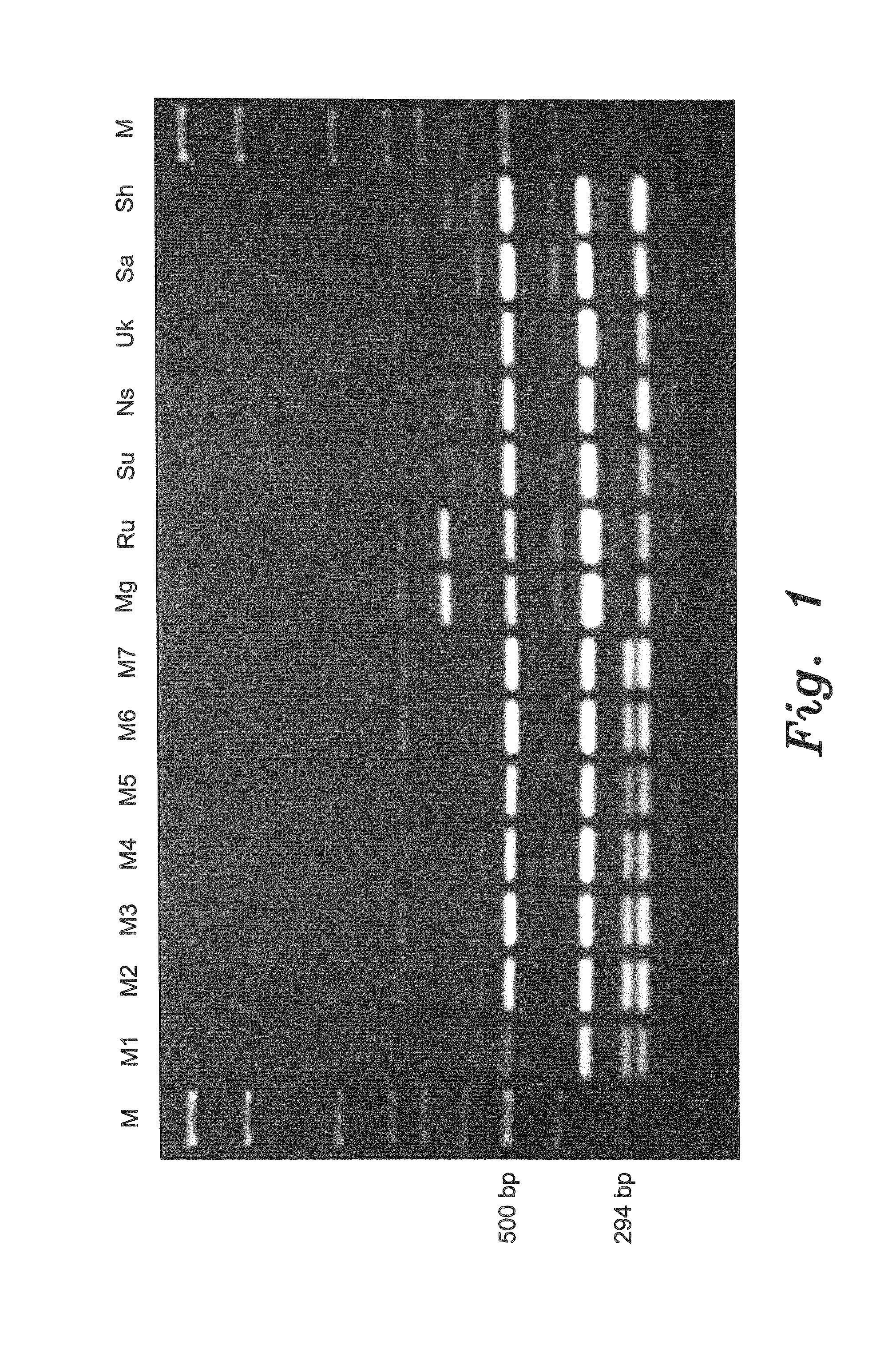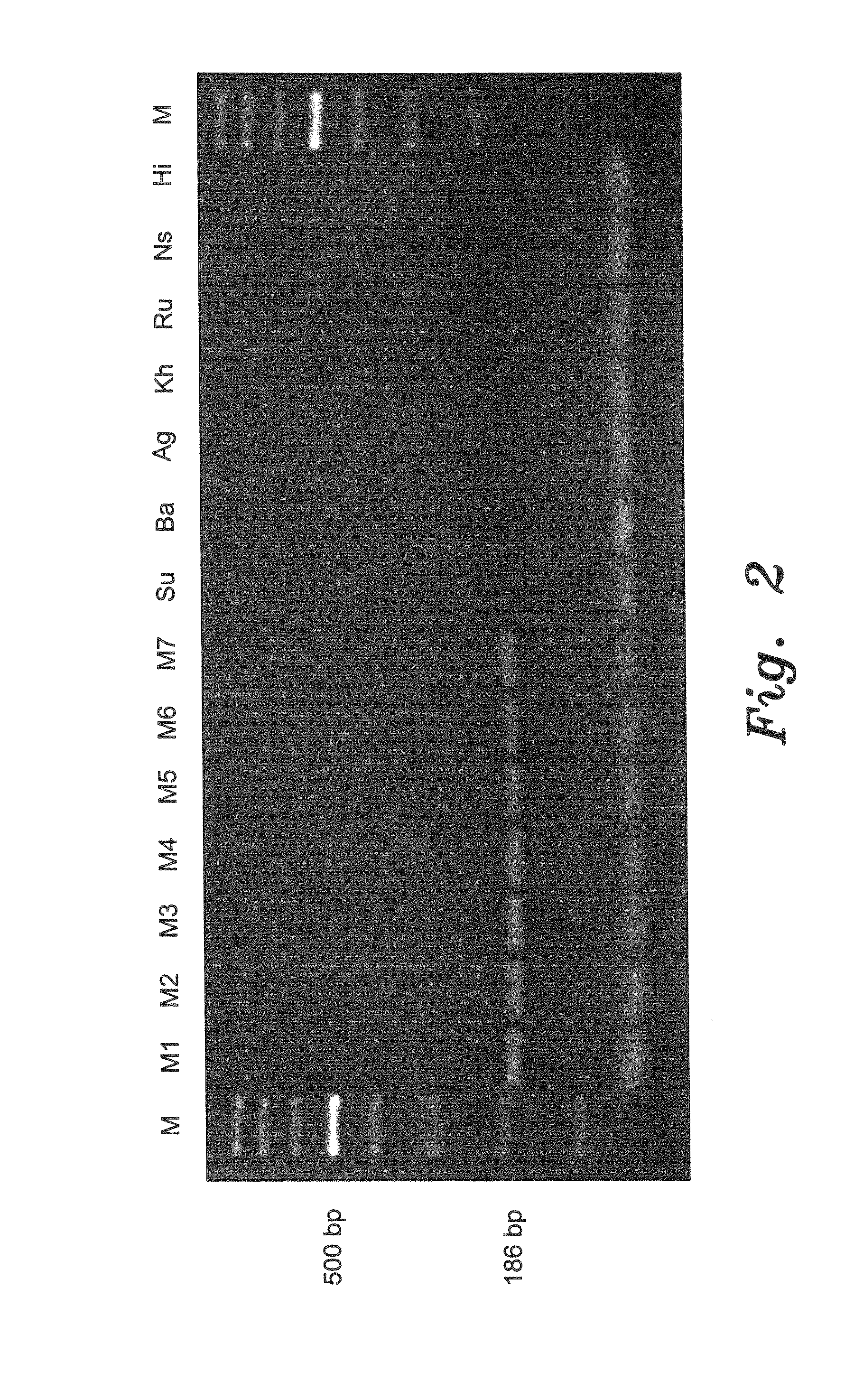Method of identifying date palm gender using scar primers
a date palm and gender technology, applied in the field of identifying date palm gender, can solve the problems of reducing genetic diversity, significantly increasing the cost of cultivating dates from seeds, and inability to determine the gender of individual date palm plants
- Summary
- Abstract
- Description
- Claims
- Application Information
AI Technical Summary
Benefits of technology
Problems solved by technology
Method used
Image
Examples
example 1
[0034]Genomic DNA was extracted using reagents from Qiagen. Date Palm varieties were collected from Dirab, Saudi Arabia. Small pieces of Date Palm leaf tissue (200 mg) were frozen in liquid nitrogen and ground to a fine powder in a mortar. The frozen-ground tissues were transferred to 2 ml micro-centrifuge tubes and mixed for ten minutes in 800 μl of extraction buffer (preheated to 65 degrees Celsius) with 10 microliters of RNase A (10 mg / ml). Three percent of PVP (Qiagen) and beta-mercaptoethanol were added and mixed by inversion. The mixture was incubated at 65° C. for 30 min, with inversion every five minutes. The mixture was cooled to room temperature, and an equal volume of chloroform: isoamyl alcohol (24:1) was added and mixed frequently for 20 minutes. The mixture was then centrifuged at 10,000 rpm for 10 minutes at room temperature. The aqueous phase was transferred to another tube and an equal volume of ice cooled isopropanol was added. This mixture w...
example 2
RAPD Analysis
[0035]Analysis of RAPD was used to screen 300 arbitrary sequence decamer primers (Operon Technologies). Each primer was tested using DNA from seven male and seven female Date Palm cultivars. PCR reactions were performed in 20 microliter reaction volumes containing: 4 microliters 5× HOT FIREPol Blend Master Mix Ready to Load, 2 microliters of the RAPD Primer (15 ng / ul), 2 microliters of the template DNA (25 ng / ul), and 12 microliters of deionized water. DNA amplification was performed using an Applied Biosystems 96 well thermal cycler, with a first cycle of 5 minutes at 94 degrees Celsius, forty cycles of one minute at 94 degrees Celsius followed by one minute at 36 degrees Celsius followed by one minute at 72 degrees Celsius, and one cycle of 7 minutes at 72 degrees Celsius. Amplification products were analyzed by gel electrophoresis in 1.3% agarose gel with 1×TBE (Tris / Borate / EDTA) buffer. Gels were stained with ethidium bromide and visualized with UV light. Each ampli...
example 3
Unique Band Selection from RAPD Profile
[0036]A DNA marker that was present in corresponding male or female samples and absent in the alternate sex samples was recognized as a potential sex-linked marker. Further PCR analysis of the corresponding RAPD primer (SEQ ID NO: 4) was performed on additional male and female cultivars to confirm the results.
PUM
| Property | Measurement | Unit |
|---|---|---|
| volumes | aaaaa | aaaaa |
| volumes | aaaaa | aaaaa |
| volumes | aaaaa | aaaaa |
Abstract
Description
Claims
Application Information
 Login to View More
Login to View More - R&D
- Intellectual Property
- Life Sciences
- Materials
- Tech Scout
- Unparalleled Data Quality
- Higher Quality Content
- 60% Fewer Hallucinations
Browse by: Latest US Patents, China's latest patents, Technical Efficacy Thesaurus, Application Domain, Technology Topic, Popular Technical Reports.
© 2025 PatSnap. All rights reserved.Legal|Privacy policy|Modern Slavery Act Transparency Statement|Sitemap|About US| Contact US: help@patsnap.com


